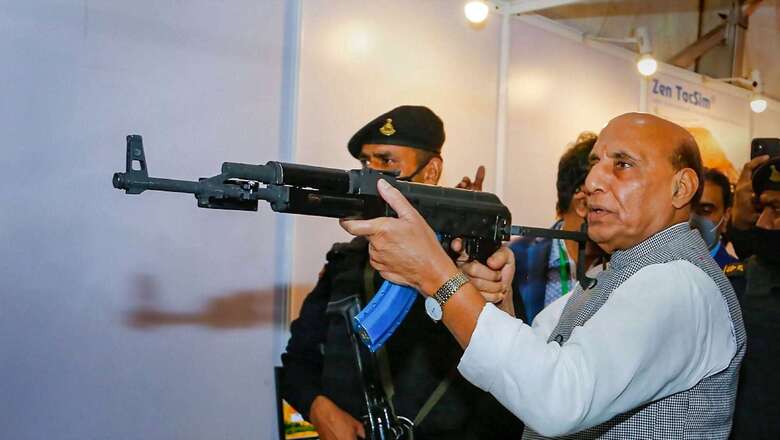
views
In the thick of the border tensions with China in mid-2020, India went ahead with this major procurement while gearing up for a long haul through many icy winters of eastern Ladakh. Under the Logistics Exchange Memorandum of Agreement (LEMOA) —a pact between India and the United States—the country bought hundreds of sets of extreme cold winter clothing from the US for its troops, who were steadily getting deployed at the Line of Actual Control (LAC) in tens of thousands.
The rushed, emergency procurement in the aftermath of the bitter Galwan Valley clashes happened because no domestic vendor was manufacturing these clothing systems back home—even as they have been a critical gear of the Indian troops at the Siachen glacier for over three decades—possibly due to lack of adequate research and development, and orders.
Cut to December 2021. About three months ahead of the glitzy DefExpo 2022—India’s major flagship defence event to be held in Gujarat’s Gandhinagar in March—the defence ministry ordered a major review of all its Buy (global) procurements. Aimed at striking off the list all those that seemed to be not of immediate operational necessity, the order explicitly stated that there would be no import of defence equipment “going forward”.
Shake-up
This suddenness of the directive left much of the defence establishment in a tizzy. A mad rush ensued to assess which of the planned foreign procurements could stay back on the list.
A lot of chatter is still underway over the pros and cons of the move. I do feel it will go some way in creating a fresh momentum towards the goal of Atmanirbharta (self-reliance) –something that, in my opinion, India’s private defence industry should immediately latch on to. But there are doubts which beg clarity before a chopping spree starts for foreign procurements.
For instance, how aligned is India’s goal towards Atmanirbharta with the country’s military objectives? What are the structural changes needed for the growth and sustenance of an indigenous defence ecosystem? How robust is India’s defence research and development for this?
In the following paragraphs, I’ll try answering some of these questions while looking at three possible policy interventions, which the government could consider before implementing this measure.
Cap foreign buying by DPSUs, boost research for private sector
There are no two ways about the need for strong indigenous defence industry. It will not just save costs but also earn revenues through exports and create jobs. On average, India ends up spending up to three times the amount of imported defence equipment for its spares and maintenance. In the instance of a conflict or other operational exigencies, the domestic industry can ramp up the production of weapons and equipment.
But first, let’s look at some data here.
India is the third biggest military spender in the world at $72.9 billion in 2020, as per the Stockholm International Peace Research Institute (SIPRI) report.
But an analysis of open-source data shows that in the last 10 years, the amount spent on foreign procurement has been much less than that on indigenous items.
For instance, as late as 2019-20, the total defence procurement was around Rs 90,000 crore, of which nearly 58 per cent was on indigenous items and around 42 per cent on imported equipment. Much of the indigenous procurement was from DPSUs.
The data brings some cheer, but it has to first be ascertained exactly how much of the amount spent on domestic procurements from DPSUs was indirectly spent on foreign original equipment manufacturers (OEMs) by way of buying critical parts.
It is no secret that India is still dependent on foreign OEMs for much of the critical defence technology needed to make, say, an aircraft or even the latest loitering munitions. India’s indigenous fighter jet LCA Tejas has an imported engine even though the government has assured of developing an indigenous engine for its variants. 25 per cent of the recently commissioned INS Visakhapatnam destroyer has foreign content.
Until India develops capabilities in building such critical military tech, the government should ideally first cap the amount a DPSU can spend on buying parts from foreign OEMs when it manufactures equipment if it has to reach Atmanirbharta in the true sense. The cap should then be progressively lowered until a DPSU manufactures equipment that is 100 per cent indigenous.
This could be done by identifying areas of little expertise and strengthening them to achieve 100 per cent capabilities, while restricting imports in areas where India already has expertise. This would go a long way in ensuring India’s operational edge is not blunted.
Secondly, we also need to reassess our efforts towards research and development of creating critical defence technology and also the emerging ones.
As per budget data, the capital funds allocated to the Defence Research and Development Organisation (DRDO) in 2020-21 was Rs 10,532 crore but it could spend a little over Rs 7,500 crore. In the previous financial year, it was allocated Rs 10,484 crore but spent only about Rs 8,600 crore.
While DRDO is struggling to spend its budget, no substantial research funds have been purely earmarked for private defence research, even as the industry is expected to pitch in heavily towards the goal of self-reliance.
Additionally, the services too have to pitch in with more research. The Navy has been more progressive in this aspect, with the creation of a naval design cell and commissioning officers specialising in shipbuilding from 1962.
Thirdly and finally, aside from incentivising the domestic private industry, they should be encouraged to work closely with the DPSUs and not compete with each other.
With a new defence production and export promotion policy on the cards and the government issuing 194 industrial licences in the past five years to private firms for manufacturing ammunition, radars, artillery guns and ships, a synergy between the two by way of technology or infrastructure sharing will go a long way in boosting indigenous defence production.
Read all the Latest India News here




















Comments
0 comment